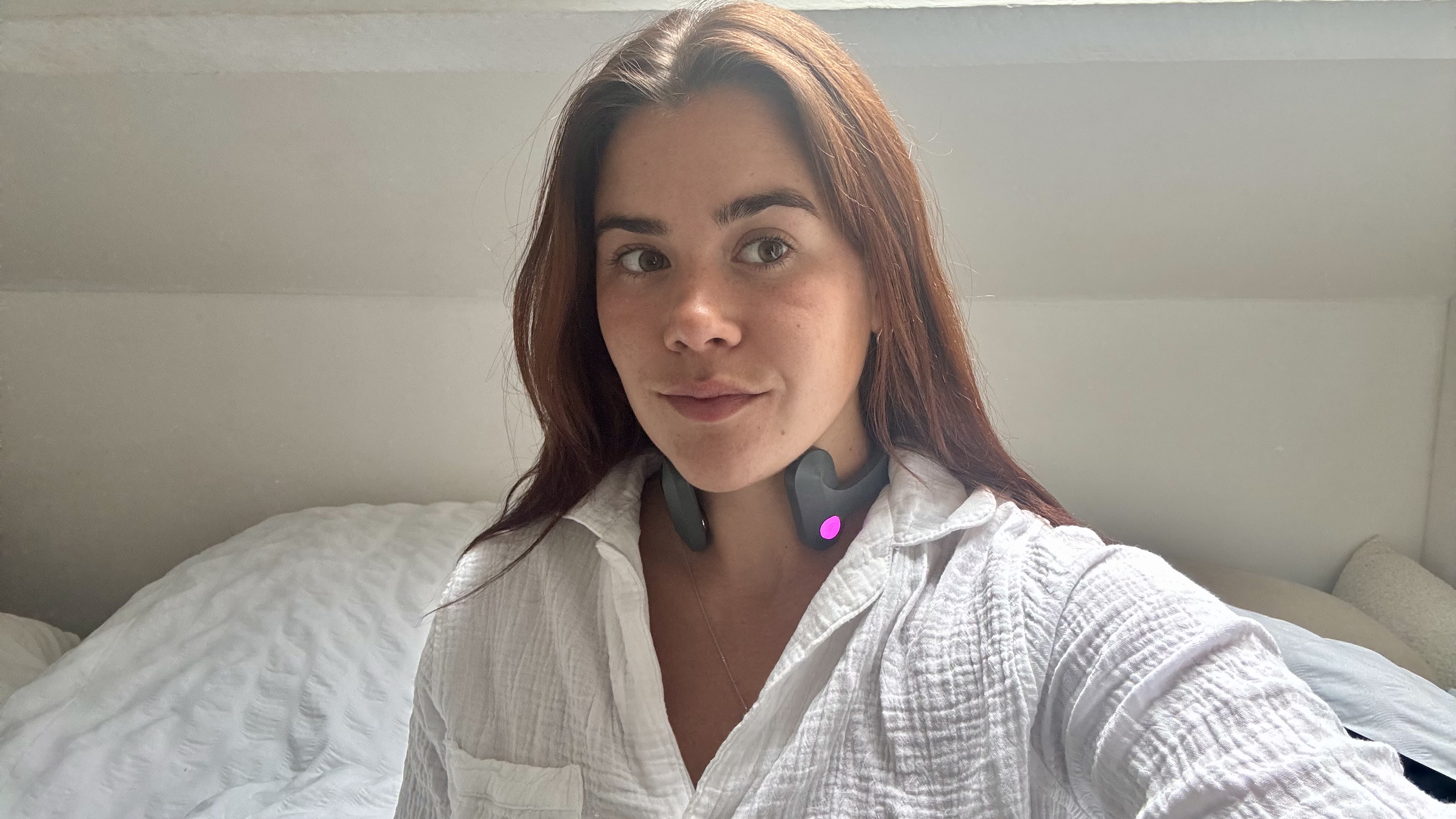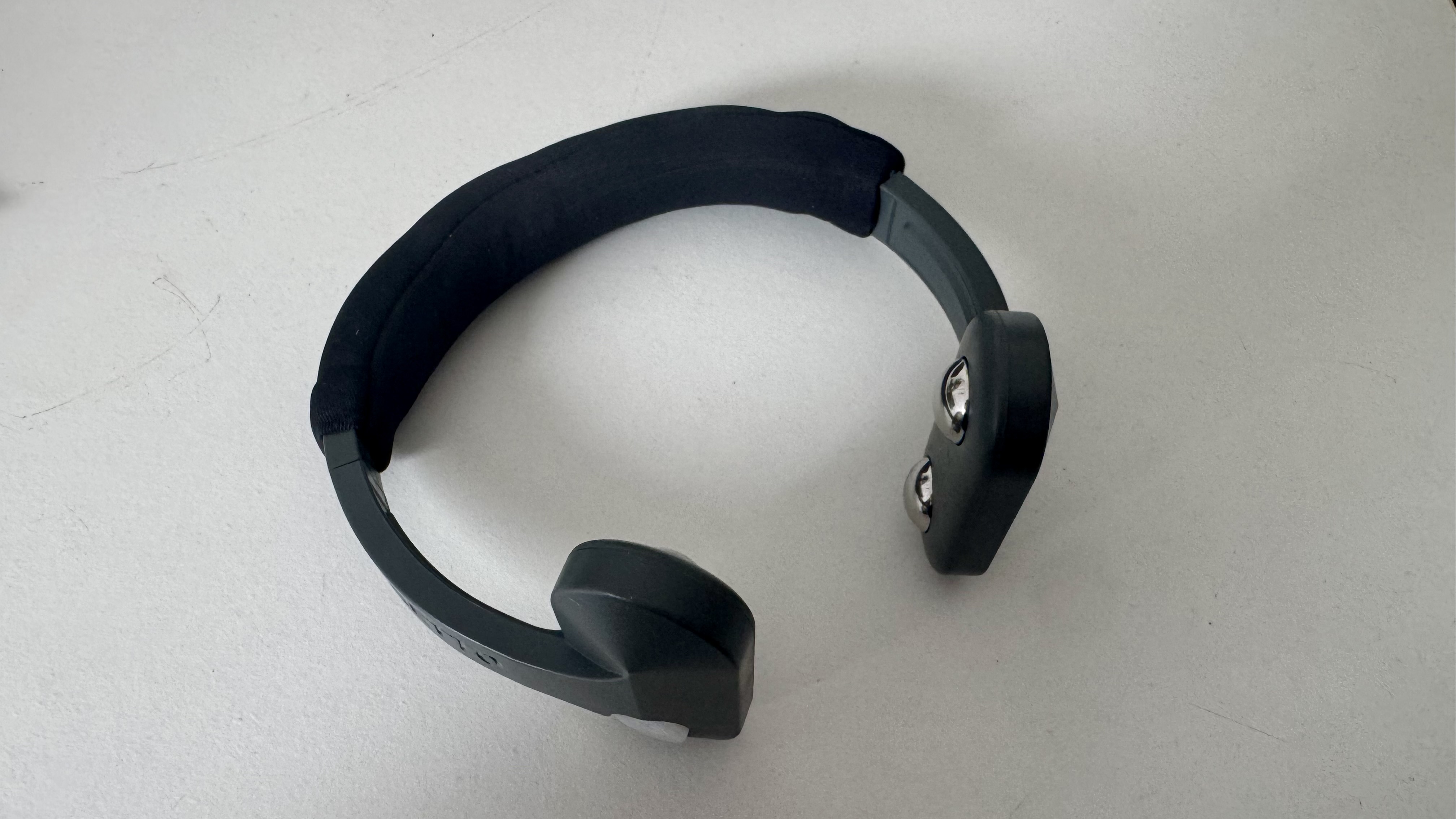Everyone's talking about vagus nerve stimulation — but can it really help you sleep? I tried Pulsetto to find out
My thoughts on vagus nerve stimulation after using Pulsetto for a week

When I first picked up the Pulsetto, a vagus nerve stimulator, I was apprehensive about how this dog-collar-looking device could help me sleep.
I've tried a fair few sleep-enhancing gadgets from the state-of-the-art smart beds to the best sunrise alarm clocks and sleep trackers. But so far, nothing that has a direct influence on my nervous system.
Now, I must admit, I am usually a good sleeper. It is my job, after all, to find the best ways to optimize my sleep.
But if I do occasionally struggle to nod off it tends to be after a busy weekend where booze is involved — it's true, alcohol can really sabotage your sleep and trigger anxiety.
After a weekend away, I was keen to see if this device — which promises improved mood, lowered anxiety and better sleep — could help me beat hangxiety and get a good night's rest.
What is Pulsetto?
The Pulsetto vagus nerve stimulator is a non-invasive, neck-worn device that delivers electrical impulses to the vagus nerve.
How does it work? You apply an electrode gel to the device's pulse points that contact the skin, and place it around your neck. Start your preferred programme in the app, sit back and relax.
Get instant access to breaking news, the hottest reviews, great deals and helpful tips.

Pulsetto provides a mild pulsation to the vagus nerve, which runs through the neck and carries information to the central nervous system. Depending on your selected programme, the pulsation will last four to 20 minutes, and you can adjust the intensity via the app.
According to the Pulsetto website, the device improves sleep quality by 18% and promises immediate results.
To test these claims, I've worn the neckband before bed for the past week.
Pulsetto Vagus Nerve Stimulator: was $478 now $278 at Pulsetto
As standard, you can enjoy five free stimulation programmes — sleep, stress, anxiety, burnout and pain — or upgrade to a premium subscription (30 day free trial then costing $10.75 a month) for three extra programmes, 54 breathing exercises and the option to connect to smart wearables like the Oura Ring.
(All prices the same in GBP for UK shoppers)
What are the benefits of vagus nerve stimulation?
If you've scrolled the internet or social media in search of stress relief tactics lately, you've likely come across vagus nerve stimulation. But what does it mean and does it really work?
The vagus nerve is the main nerve in the parasympathetic nervous system, which is responsible for maintaining bodily functions when the body is in a relaxed, rather than a 'fight or flight', state.
Vagus nerve stimulation involves using a device, be it a collar, ear piece or headband, that sends electrical impulses to the vagus nerve, which travels to the brainstem and ultimately the brain.
Stimulating the vagus nerve is said to have many benefits, all revolving around calming the body and brain as it activates the parasympathetic nervous system.
This means it helps lower blood pressure and heart rate, contributing to better cardiovascular health, promotes relaxation, reduces stress and anxiety and provides pain relief.
My first thoughts on Pulsetto
Setting up the device posed no issues. The app is easy to navigate with clear signposts and icons.
There's a section where you can log your symptoms, mood, energy levels and sleep quality to keep track of how they change (or don't change) in response to your Pulsetto use.

After getting familiar with the app, I applied the gel and placed the band around my neck. As an average size female, the band fit best on the smallest circumference.
I didn't immediately find the device comfortable. In fact I squirmed when it touched my neck.
I started on the lowest intensity (one) of sleep mode and gradually turned it up. I reached five, but couldn't bare the fuzzy vibrations on my neck, so settled back at a just-bearable two for my first night of testing.
Putting Pulsetto to the test: Night 1
The first night I used the Pulsetto was after a day of traveling. Although I was physically tired, I was finding it hard to relax with unpacking and returning to work after some time off on my mind.
Pulsetto recommends using the device 20 to 30 minutes before bedtime. So, I gel-ed up and put on the device while reading in bed.
Once the session was complete I read a few more pages and drifted off peacefully, regardless of feeling anxious just half an hour before. So far, so good.

Putting Pulsetto to the test: Night 2-7
I continued using Pulsetto device through the week. After one particularly muggy, rainy day working from home, I felt restless going to bed. But I made a point of putting on the Pulsetto and laying down for 10 minutes of enforced relaxation and mindfulness, and soon felt less irritable. Again, after a few pages, I slept well through the night.
As I used the Pulsetto as part of my already well-established nighttime routine, it was hard to tell whether it was the device alone or other sleep-promoting habits that were helping me sleep when odds were against me.
As I used the Pulsetto as part of my already well-established nighttime routine, it was hard to tell whether it was the device alone or other sleep-promoting habits
So, on the final two nights of testing, I left Pulsetto to its own devices. Instead of reading in bed with my Bon Charge red clip light, I put on the Pulsetto (braving a sleep mode intensity four) and laid down to relax.
On the first of the two nights, I have no tossing or turning to report and slept well through the night, gaining a 94 sleep score, according to my Eight Sleep Pod 4 smart mattress cover.
That said, I still felt sleepy when my alarm sounded for me to get up for a gym session the next morning. Were Pulsetto's snooze-inducing effects that long lasting, or was I still catching up on sleep debt from the weekend? I'd say the latter.
The following night, however, was a different story. Inflicted with stomach cramps (thank you, mother nature) I struggled to nod off even after completing the sleep programme on intensity five (the highest my flinching neck could stand) and woke up frequently though the night.
Are there any drawbacks?
At $478 MSRP, this sleep gadget isn't cheap. You must also use a gel with it, although one bottle comes with the device (and goes a long way), you’d need to repurchase for continued use, incurring more expense.
Pulsetto recommends using the device two times a day for the best results. Remembering to do this amid an already busy-schedule can feel like a chore.

The Pulsetto device also comes with a warning of potential side effects including irritation at the application site, dizziness, headache or muscle twitching in the face and neck.
Although these side effects are said to resolve immediately after the stimulation is complete, they can be alarming. And for what it's worth, I didn't experience any side effects.
Pulsetto also warns against pregnant people, people with active medical implants (pacemakers or hearing aids), heart arrhythmias or breathing problems using it.
Is Pulsetto worth it? My thoughts
Although Pulsetto stood no chance against period cramps, I'd say it did a decent job of helping me relax the previous nights.
Be it placebo or not, I have slept better than I usually would post-boozey-weekend while using the Pulsetto before bed. Yet the cynic in me says this is not solely due to Pulsetto, but a combination of healthy sleep habits.
In all honesty, I'd say save your dollars. The neckband works on more or less the same mechanism (calming the nervous system) as guided sleep meditations, breathwork and relaxation techniques have done for decades.

Eve is a sleep tech product tester and writer at Tom's Guide, covering everything from smart beds and sleep trackers, to sleep earbuds and sunrise alarm clocks. Eve is a PPA-accredited journalist with an MA in Magazine Journalism, and has four years’ experience writing features and news. In her role as Sleep Tech Product Tester and Writer for Tom's Guide, Eve is constantly trying out and reviewing the latest sleep products from brands such as Apple, Garmin, Whoop, Hatch, Sleep Number, Eight Sleep, and Oura. A fitness enthusiast who completed the London Marathon earlier this year, Eve loves exploring the relationship between good sleep, overall health, and physical performance, and how great sleep tech can make that relationship even better.
You must confirm your public display name before commenting
Please logout and then login again, you will then be prompted to enter your display name.

